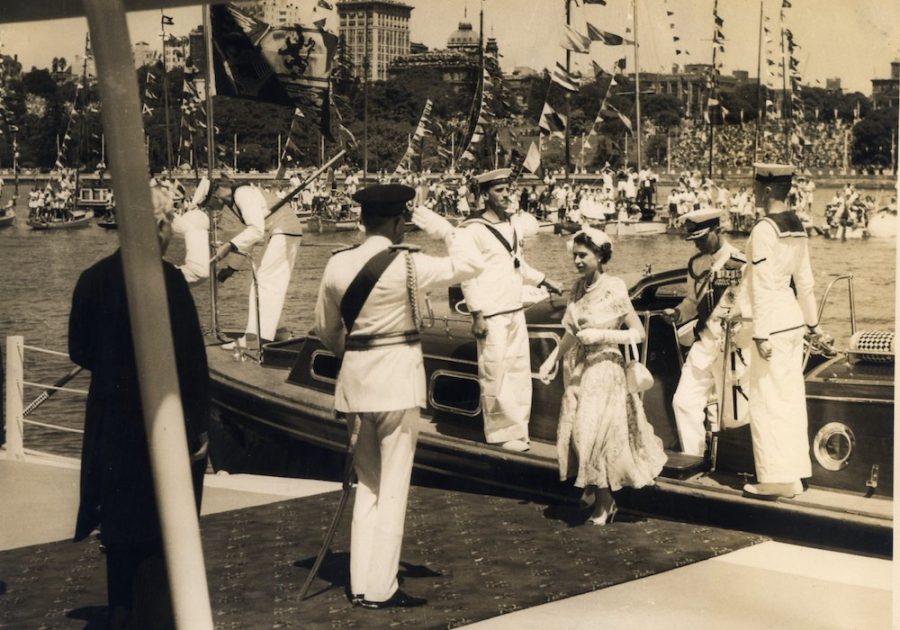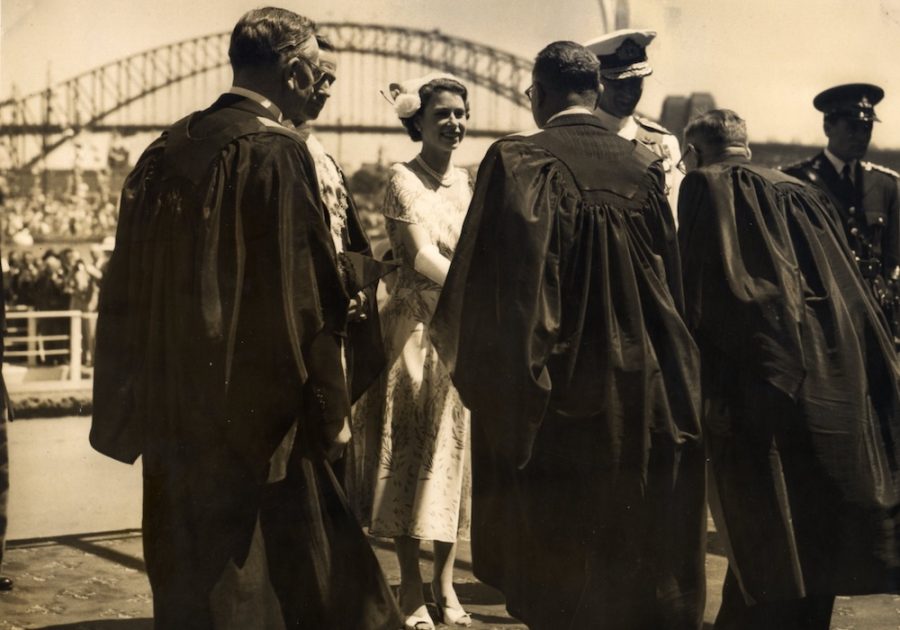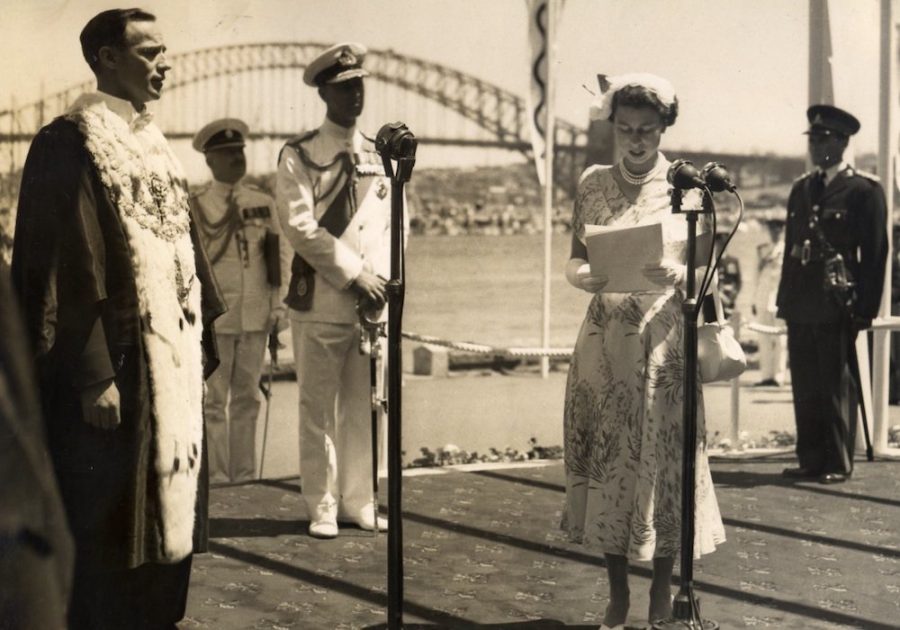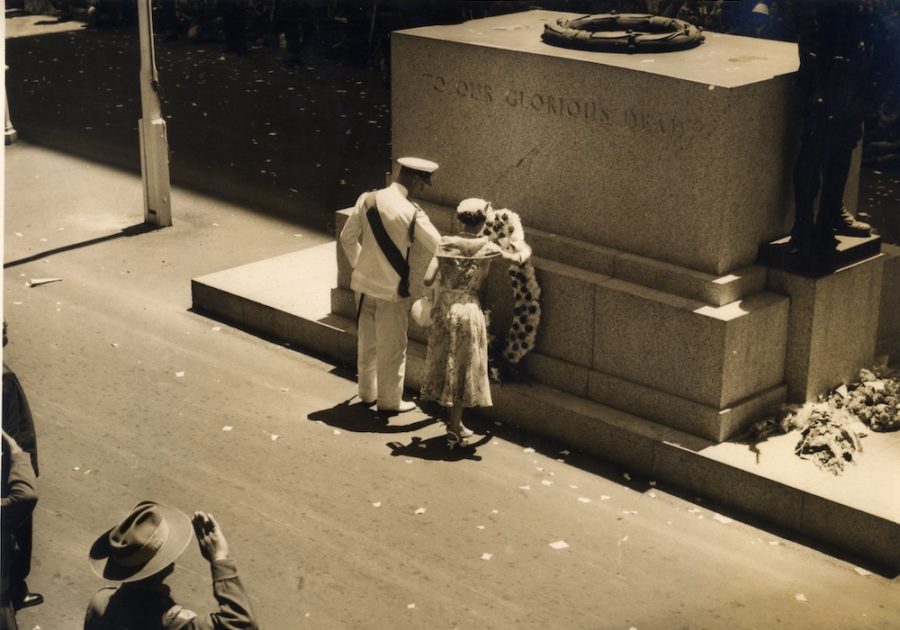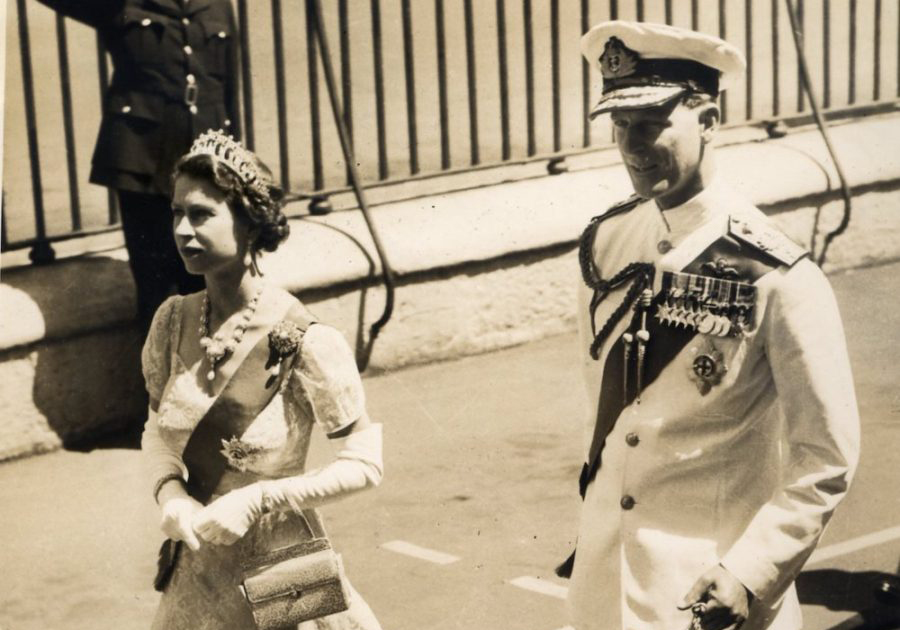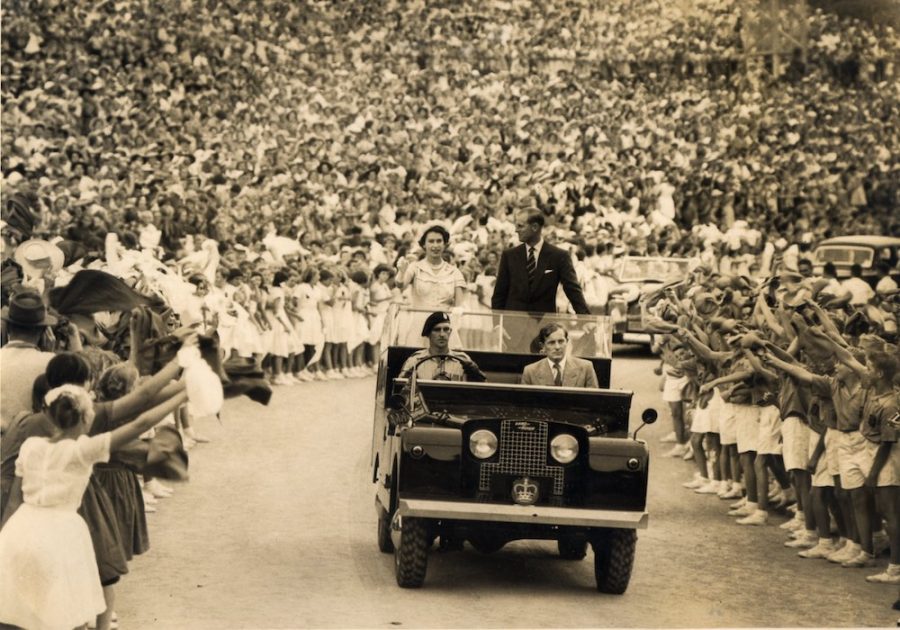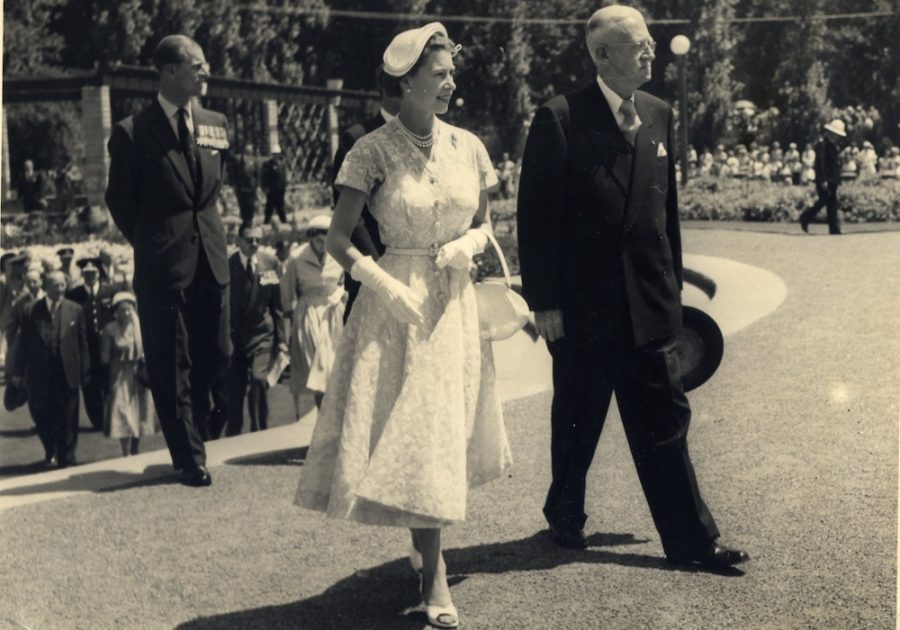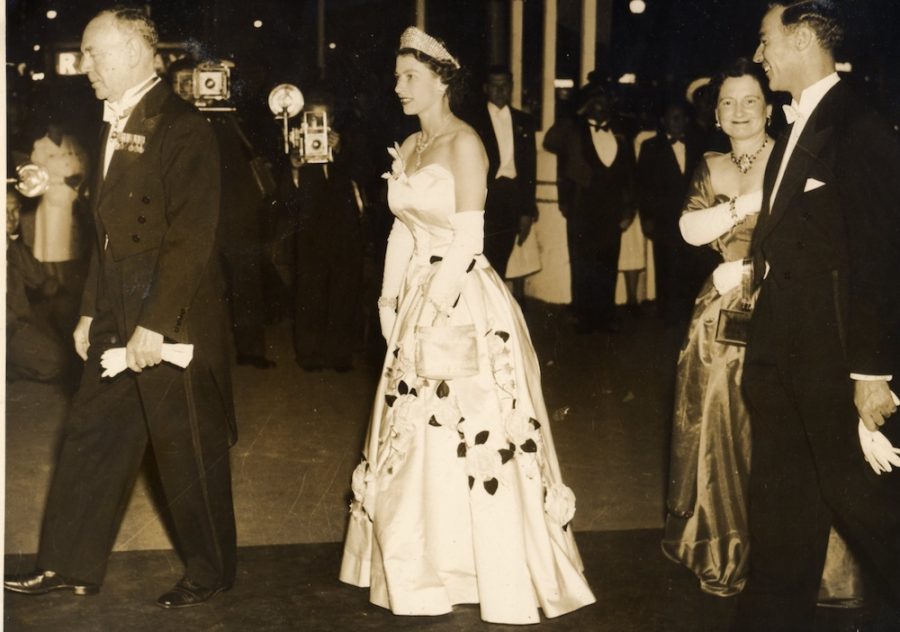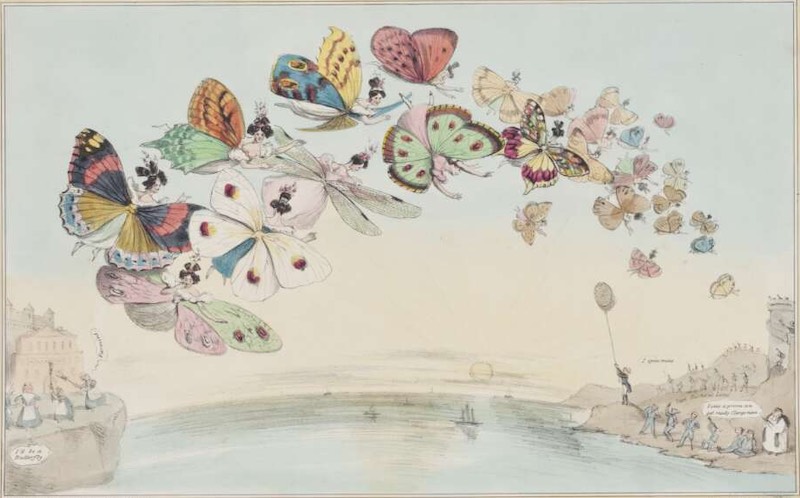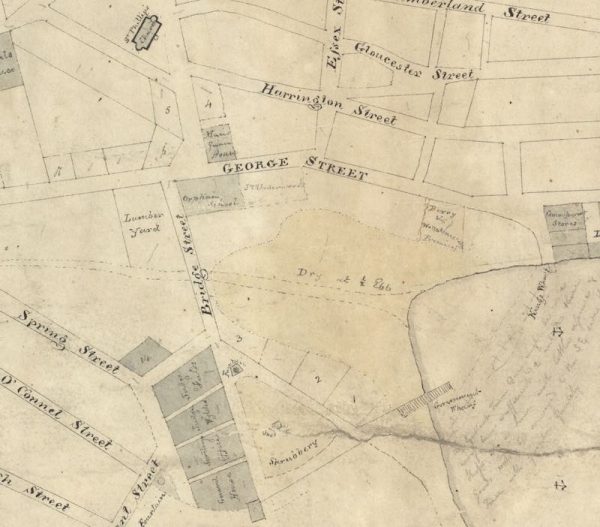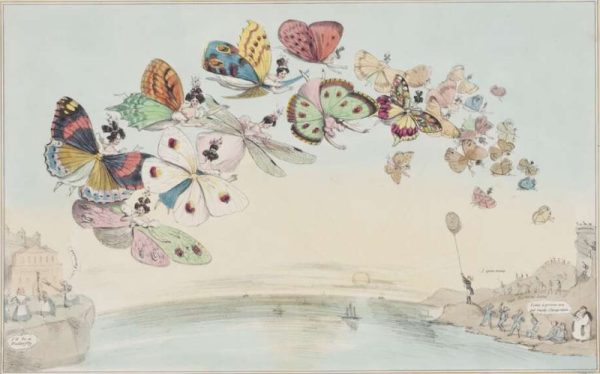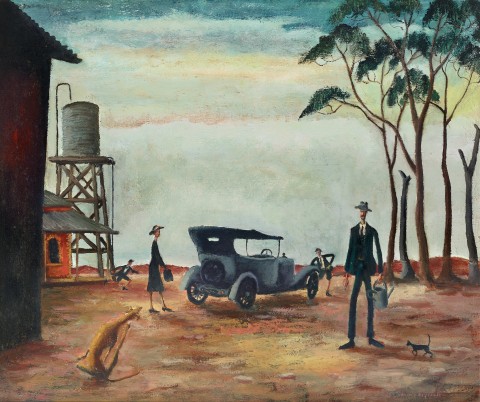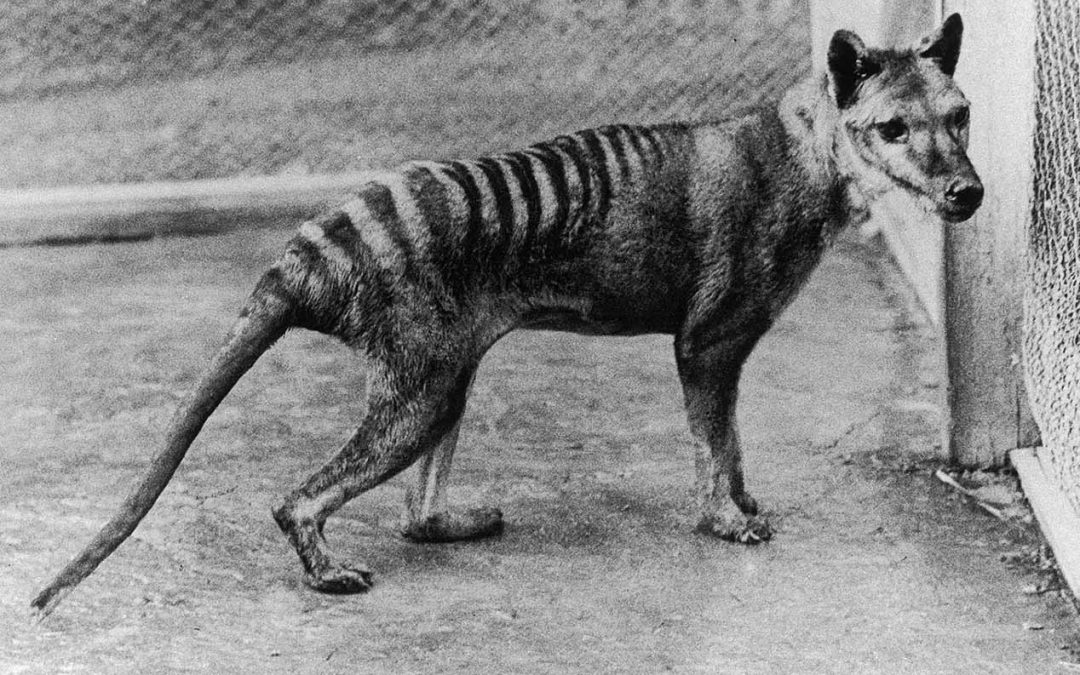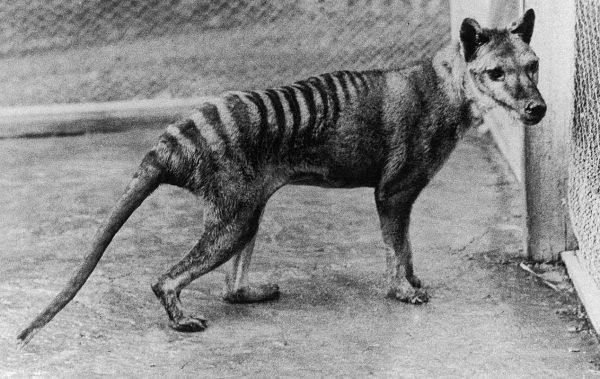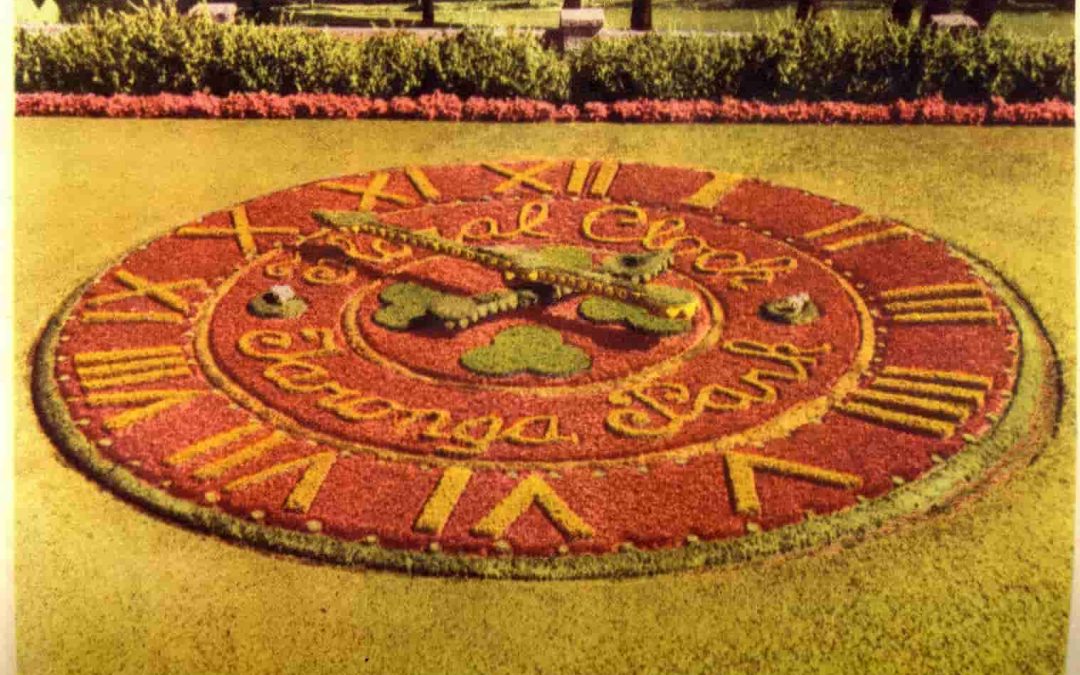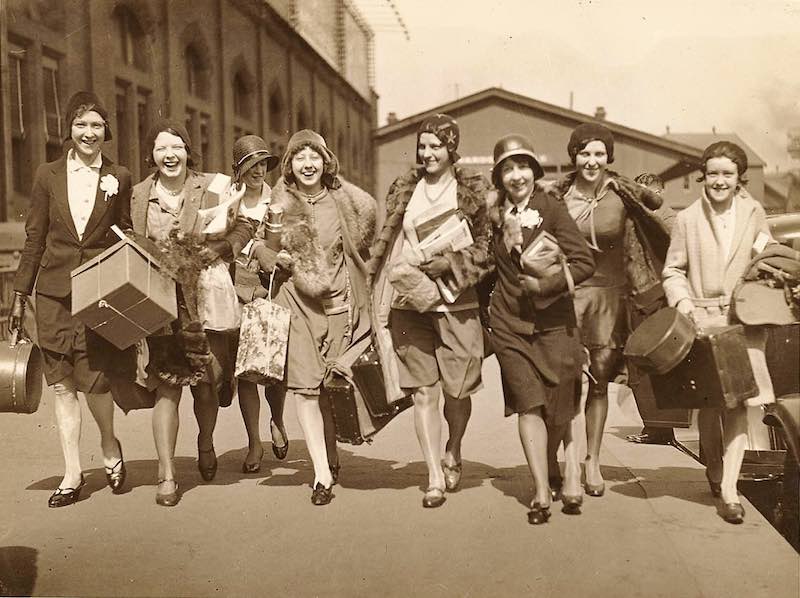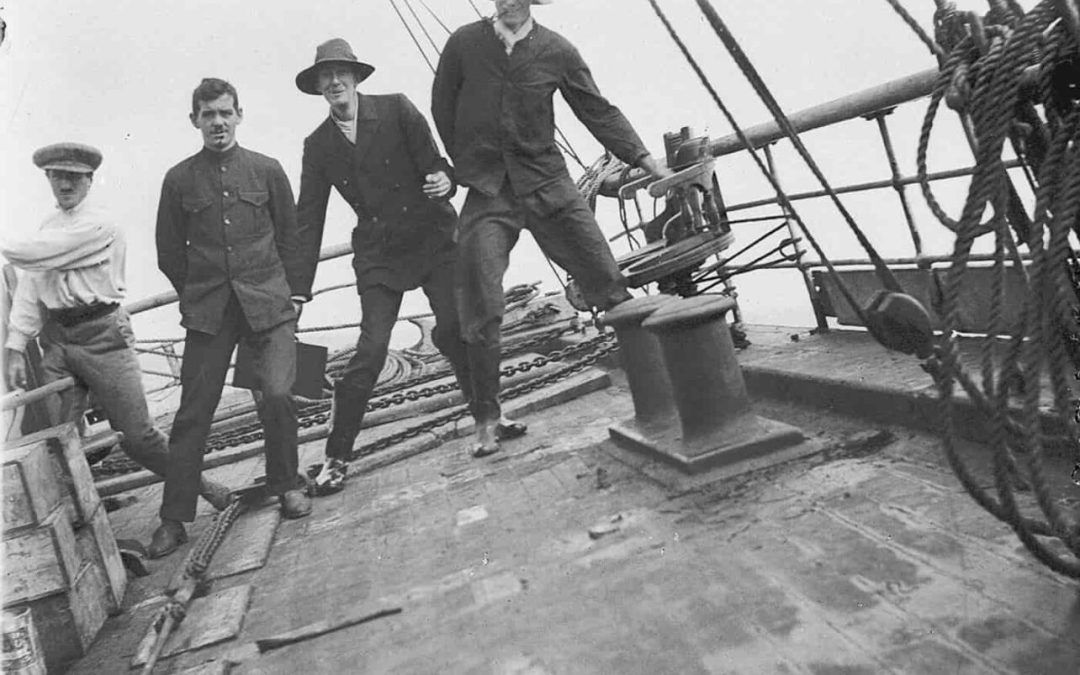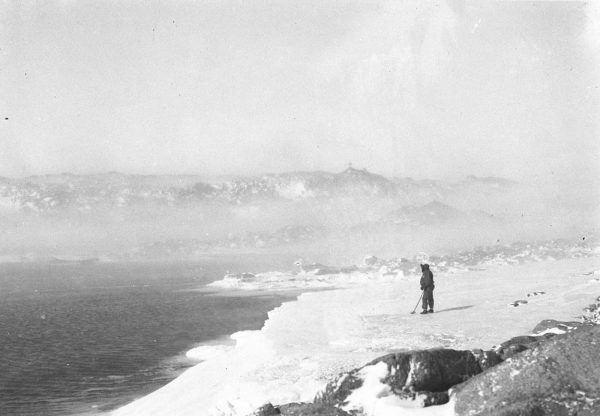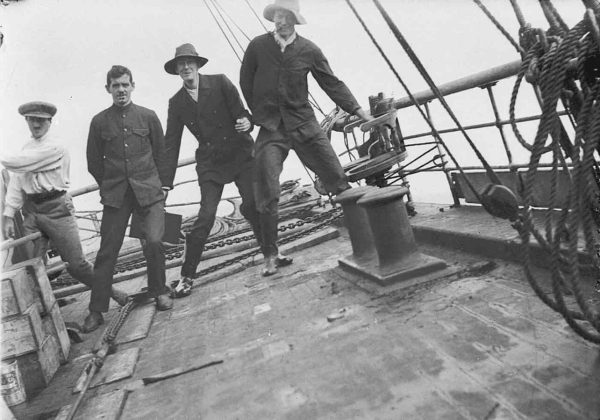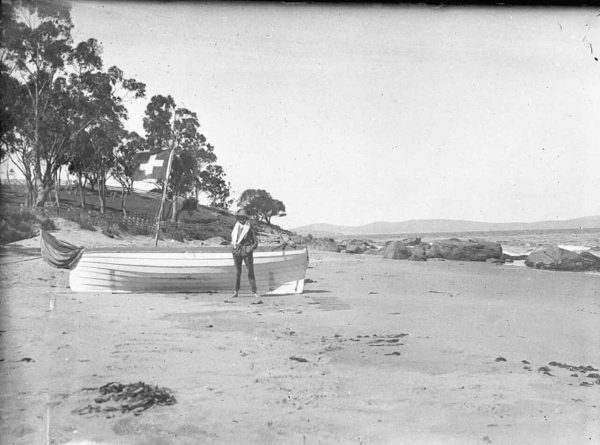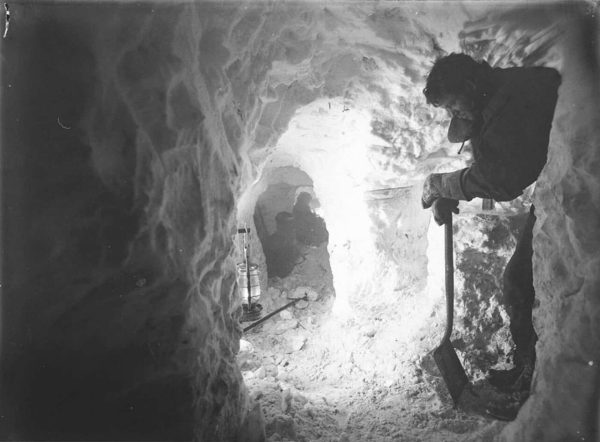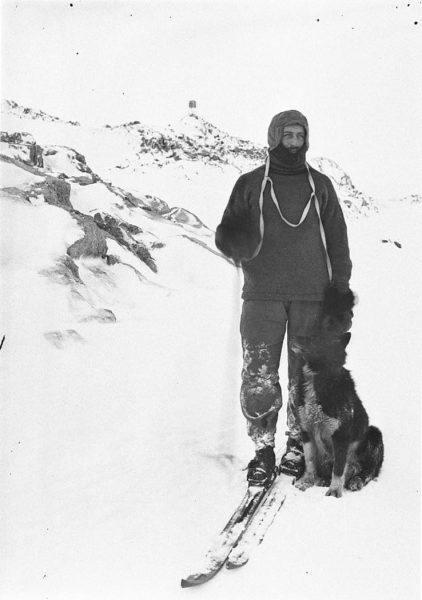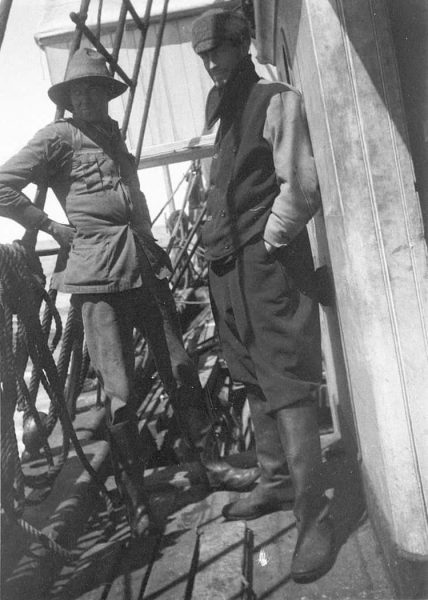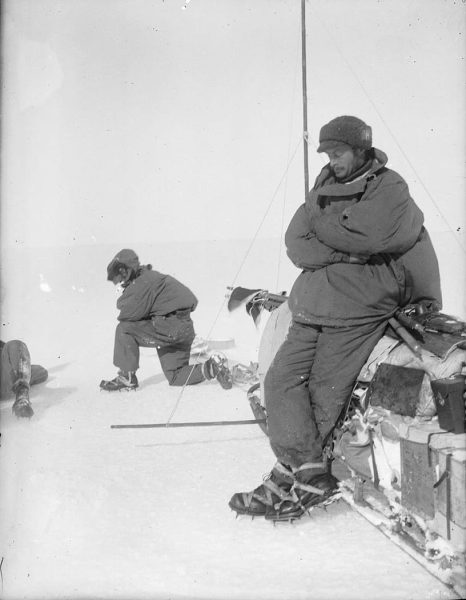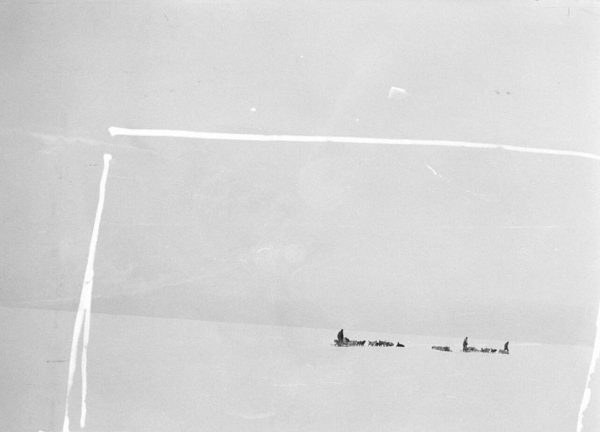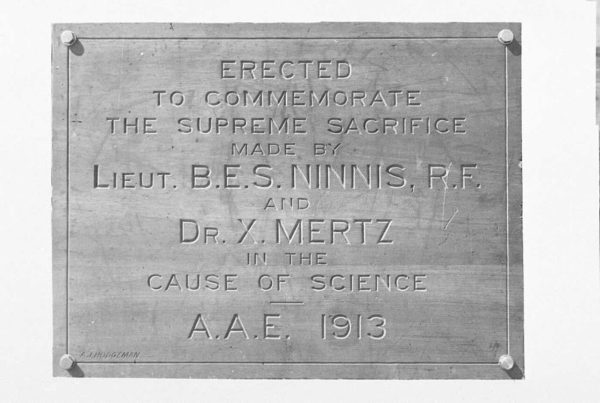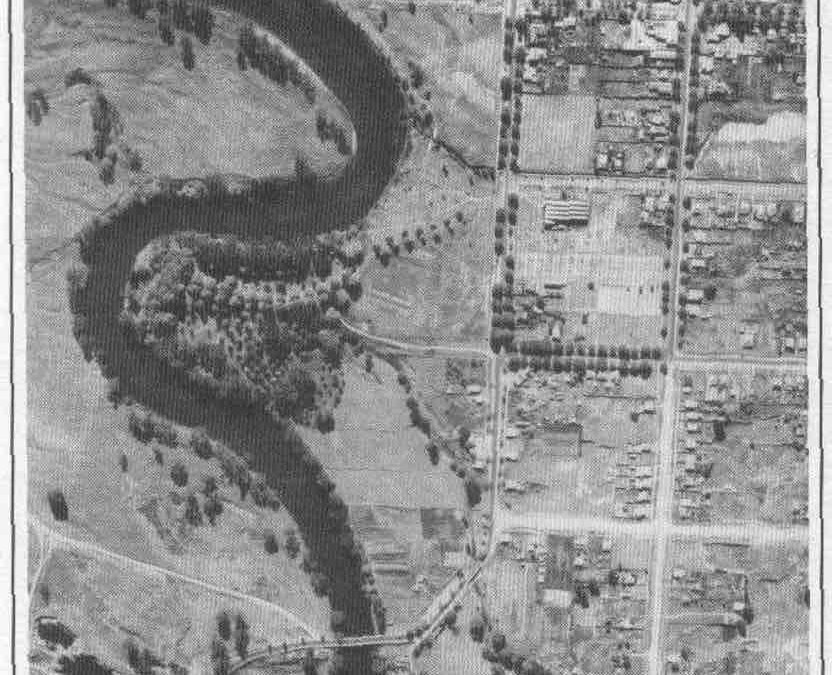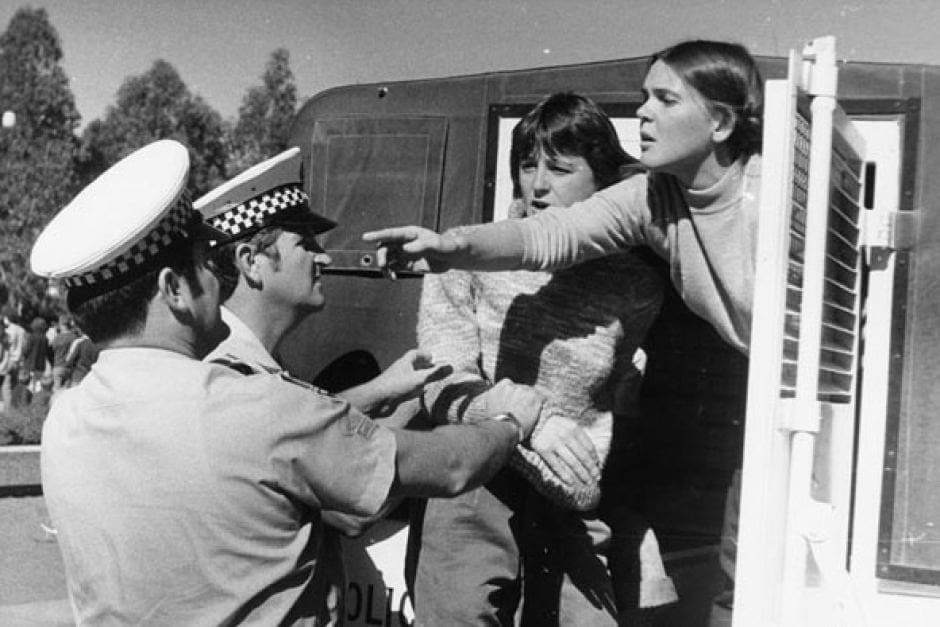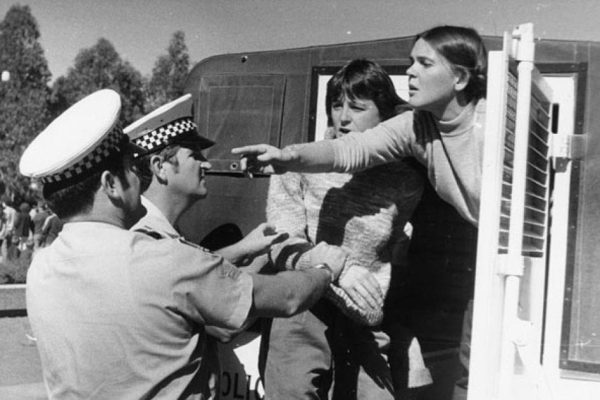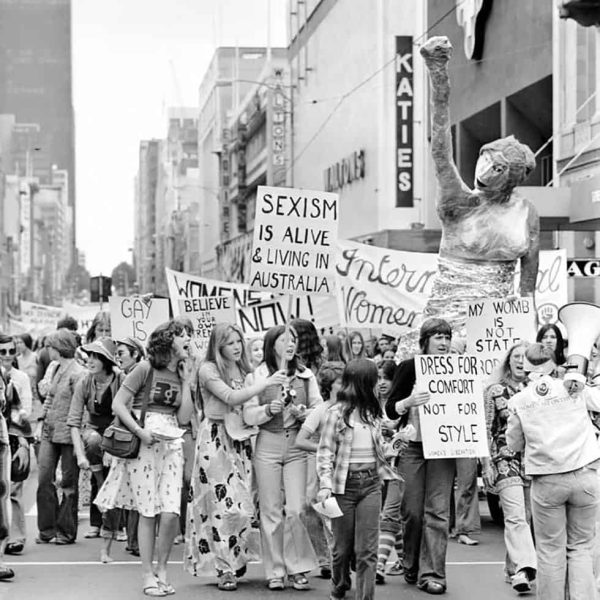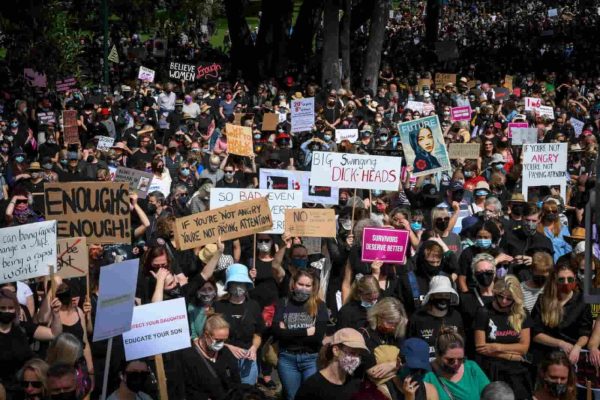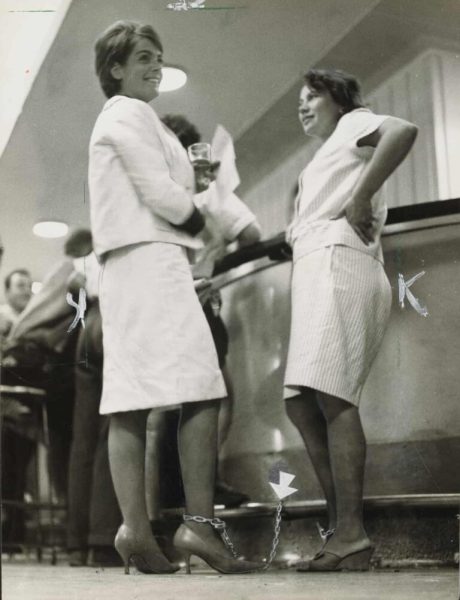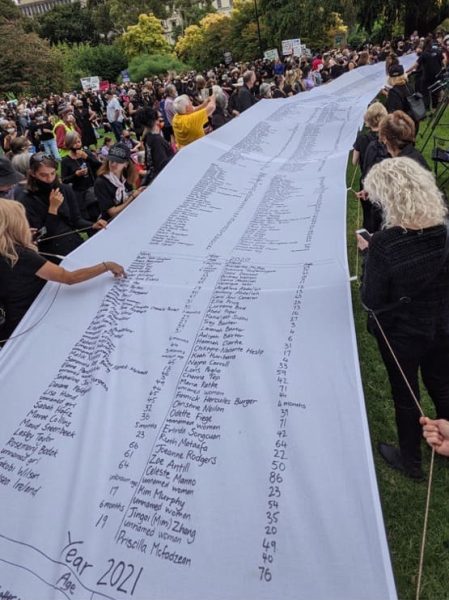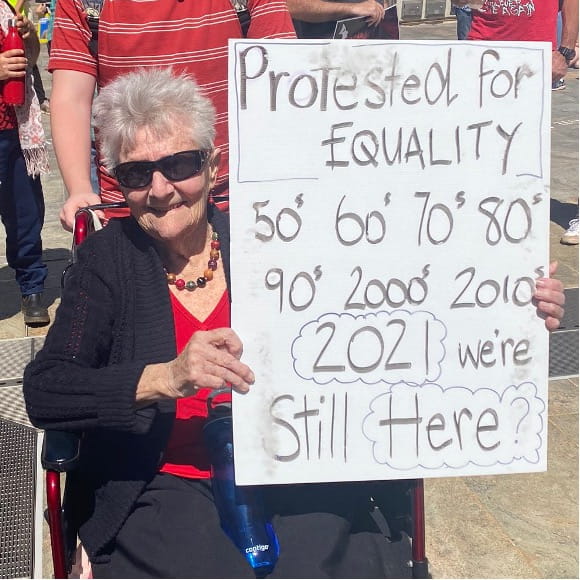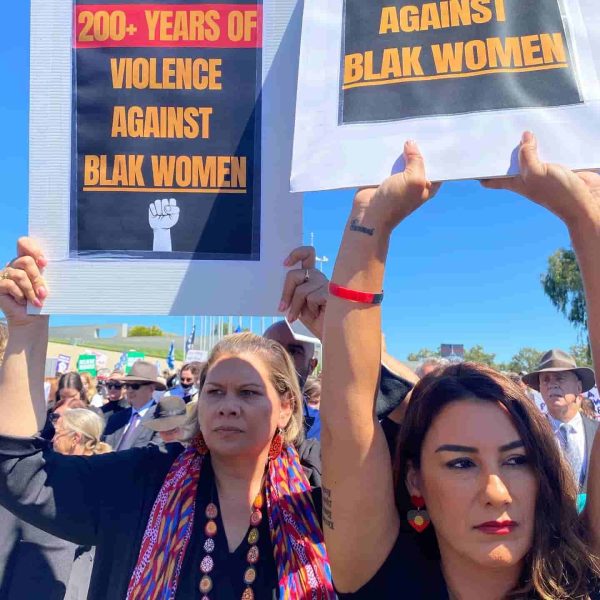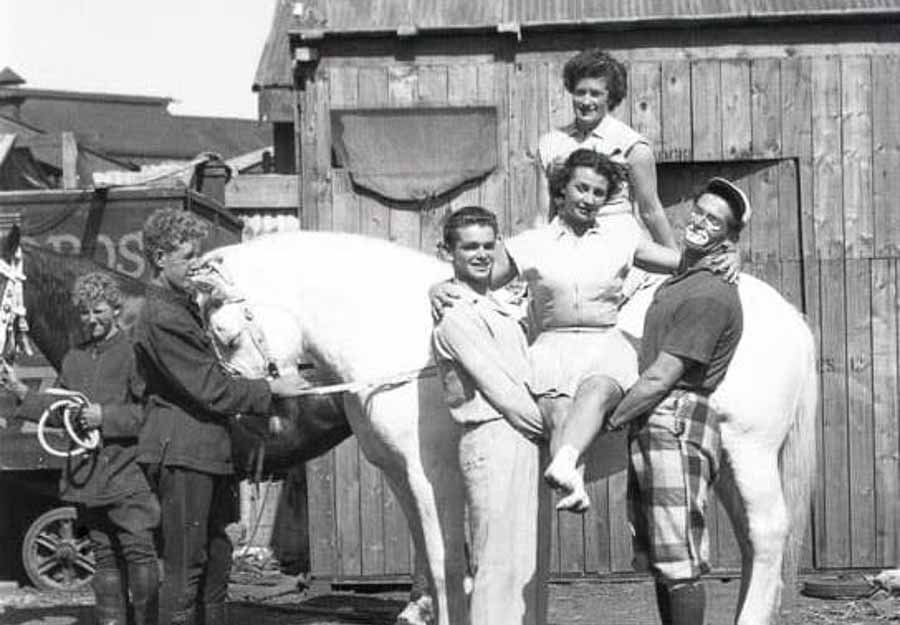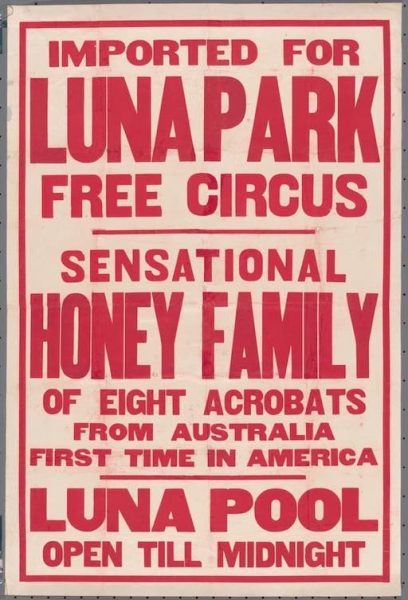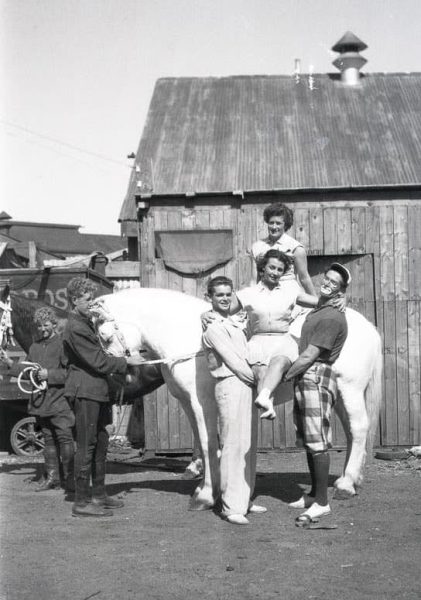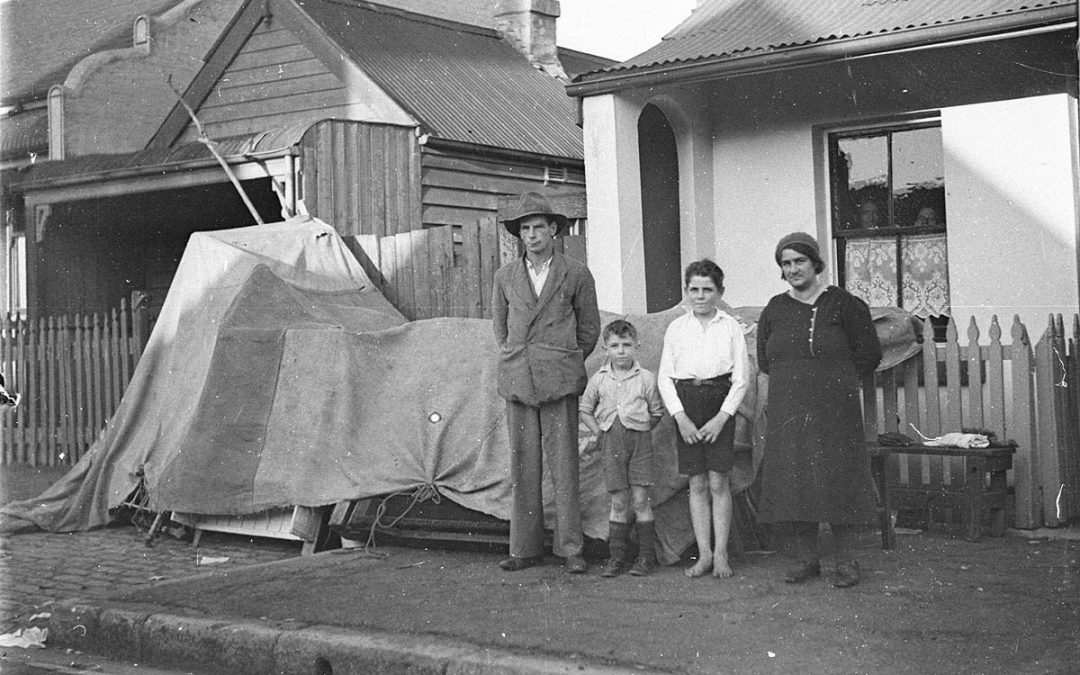On Saturday 6 November 2021, the RAHS held a special online event, exploring the Exciting New World: Australia in the 1920s and 1930s. This is the second in a series of two blog posts about the interwar decades, providing an overview of the broad spectrum of changes that occurred across Australian politics, society, and culture during that time.
Read the first instalment here
If the 1920s was a decade defined by change, the 1930s was one of hardship.
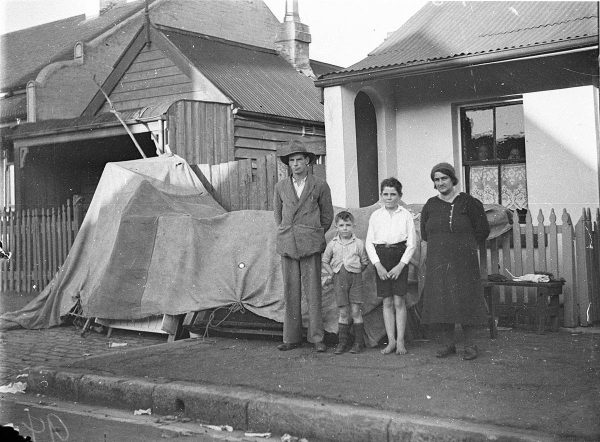
WILLIAM ROBERTS, AN ORIGINAL ANZAC, AND HIS FAMILY EVICTED FROM THEIR REDFERN HOME INTO THE STREET DURING THE DEPRESSION, 28 SEPTEMBER 1934. PHOTOGRAPH BY LETHINGTON MAITLAND, COURTESY STATE LIBRARY OF NSW
Bookended by the stock market crash on Wall Street in 1929 and the outbreak of the Second World War in 1939, today the term ‘1930s’ is used almost interchangeably with ‘the Great Depression’. They were years characterised by economic upheaval, skyrocketing unemployment rates, political and social unrest, and the shattered promise of the 1920s Australian dream. Families were evicted from their homes with such regularity they became the quintessential image of the decade.[1] Veterans of the Great War fell upon the hardest of times since Gallipoli. The country’s greatest aviation heroes disappeared right out of the sky. Aboriginal and Torres Strait Islander peoples continued to clash against the same socio-political structures of discrimination and repression they had faced since colonisation.
Yet just as the ‘Australia Unlimited’ promised by the 1920s was not a reality for all, so too were there glimmers of hope amidst the otherwise bleak Depression years.[2] Modernism in Australian art and culture continued on its upwards trajectory. The great sporting achievements of Don Bradman and Phar Lap gripped the nation. Technological and architectural innovation persisted in the establishment of the Australian Broadcasting Commission (ABC) and the opening of the Sydney Harbour Bridge, both in 1932.
The Australia that declared war against Germany in 1939 was a far cry from the Australia that had emerged from the Treaty of Versailles in 1919. Its transformation into an exciting new world had as much to do with the trials and tribulations of the 1930s as it did with the 1920s ‘Jazz age’.
Disillusionment and the Great Depression
The American stock market crashed in October 1929, one week after James Scullin’s Labor government won its largest majority in federal parliament. The Australian economy was already under pressure due to falling wheat and wool prices in the latter half of the 1920s, and had been borrowing vast sums of money to stay afloat. This precarious balancing act came tumbling down with Wall Street. It would take the better part of the decade to rebuild.[3]
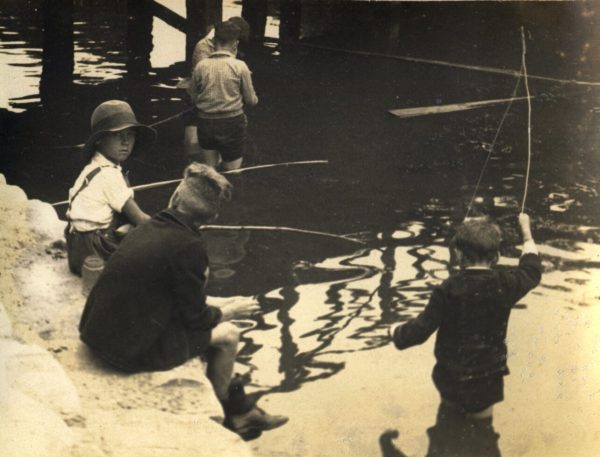
‘YOUNG SPORTSMEN’, TAKEN CIRCA 1930. RAHS OSBORNE COLLECTION
Unemployment rates reached a dizzying peak of almost 32% in 1932. One in three breadwinners were unemployed by 1933. Factory output fell by 40% between 1929 and 1931 as the government reduced wages and increased working hours from 44 to 48 per week. The state government-supplied sustenance payment—‘susso’—supported more than 60 000 Australians by 1932 but was barely enough to feed a family, let alone anywhere near the basic wage. Husbands, fathers, brothers, and sons walked the ‘Hungry Mile’ along Sydney’s Darling Harbour in search of a single day’s work, while those who lucked out in the city turned inland, shouldering their swags to become regular ‘Waltzing Matildas’.[4]
Yet rural Australia, too, held little promise: returned soldier settlers knew this better than most. From the commencement of the Soldier Settlement Scheme in 1916, more than 23 000 farms were assigned to veterans across nine million acres of the country. By the time the Great Depression hit, and hit hard, around sixty percent of those farms had been abandoned, due to poor land quality, low agricultural prices, and lack of farming experience—a task made more difficult by the physical barriers to manual labour many wounded veterans returned home with. One ABC News article describes the Depression as the final ‘nail in the coffin’ for those who remained.[5]
‘Men, money and markets’ had been the policy of the Nationalist Bruce government of the 1920s. Now there were no markets, barely any money, and too many men to know what to do with.[6]
It is no wonder that from such social and economic upheaval, politics was not far behind. Most famously, the NSW Labor Premier Jack Lang was sacked by Governor Sir Philip Game in 1932, after his refusal to pay interest on British loans.
Should men now go without the necessities of life in order that the international money ring should have its pound of flesh?
— Jack Lang, 1962
Lang’s influence extended far beyond his dismissal. The split it tore in the Labor Party persisted into the next two state elections in which Lang ran—and lost—as party leader. He never regained his former popularity, and Labor as a whole suffered for it—although today, he is remembered by some as the country’s ‘most radical Labor leader’, and by all as one of the lasting personalities from the Great Depression.[7]
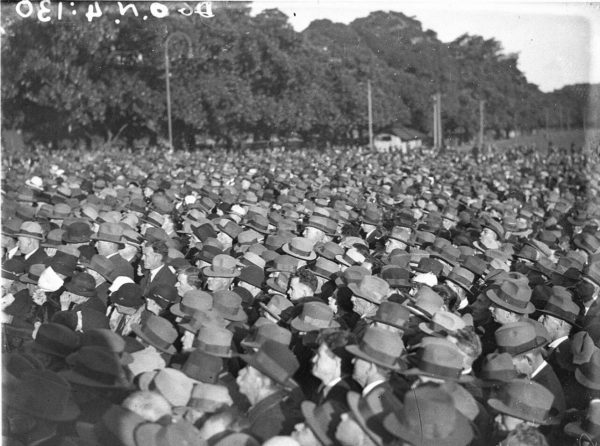
MASS RALLY IN THE DOMAIN AGAINST RAIL, TRAM AND PUBLIC SERVICE WAGE CUT, 17 JUNE 1934. PHOTOGRAPH BY SAM HOOD, COURTESY STATE LIBRARY OF NSW
The disillusionment spurred by the Depression also opened the door for the emerging popularity of radical far-right and far-left political groups such as the Community Party of Australia, which flourished among workers and unemployed alike, and the disturbingly fascist New Guard, most famous for its shocking interruption of the Harbour Bridge opening ceremony in 1932.[8]
For Aboriginal and Torres Strait Islander Australians, the Depression only added to the burdens already endured. In 1931, Arnhem Land was declared a reserve for the sole purpose of segregation. In 1936, the Western Australian Aborigines Amendment Act granted the minister for Native Affairs the right to take Indigenous peoples into custody without trial or appeal. When a 1937 petition to King George VI was circulated by William Cooper of the Yorta Yorta people of northern Victoria, requesting civil rights and an Indigenous leader in parliament, the Australian government refused to send it. Many Indigenous Australians aligned themselves with the Communist Party but continued to be marginalised and silenced in public spaces. As former assistant curator of Sydney Living Museums Annie Stevens argued:
… for many Aboriginal people the Great Depression never ended.[9]
The effects of the Great Depression were felt beyond the 1930s. Even once the economy had recovered, it took Australian society some time to pick itself up from the curb and follow suit. But the second of the interwar decades was not all doom and gloom. The train of modernity was rapidly gaining pace around the world, ushering in new freedoms, artistic expressions, and cultural norms. It took everything Australia had to keep up.
‘Optimism and despair’: Modernism, modernity, and the Melbourne Cup
In 2017 the National Gallery of Victoria held an Australia in the 1930s exhibition titled Brave New World, highlighting the ‘optimism and despair’ which characterised the decade, as well as the shades of grey in-between.[10] While it is true that the Depression coloured the 1930s black-and-white for the majority of Australians, moments of brilliance persisted. Reminders that, despite the hardships being faced, the world was quickly becoming a more modern, interesting, and vibrant place.
The most famous example is the completion of the Sydney Harbour Bridge. It was—and still is—the largest steel arch bridge in the world. Its two spans were joined in 1930 but it would take another two years before the bridge was finally open to traffic, and another fifty for the £4.2 million construction cost to be paid off. A poster inviting Sydneysiders to the opening ceremony features a lifeguard front and centre, gesturing proudly at the completed bridge behind him. The pinnacle of Australian manhood in peacetime, lifeguards—and the beaches they worked on—were the major drawcard for the Australian tourism industry struggling to make ends meet during the Depression. Their red and yellow uniform remains iconic, ninety years on.[11]
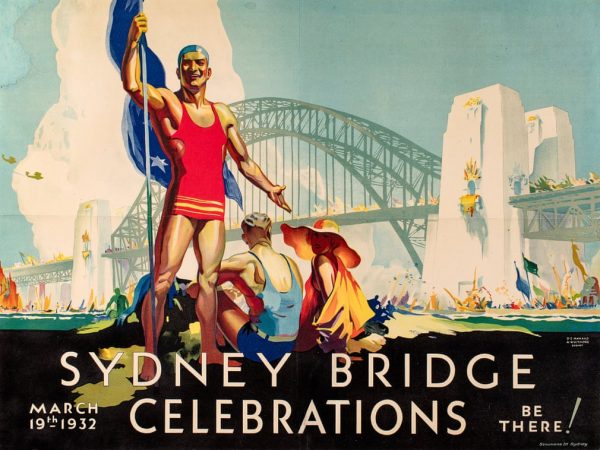
SYDNEY BRIDGE CELEBRATIONS POSTER (1932). DESIGNED BY DOUGLAS ANNAND AND ARTHUR WHITMORE, AUSTRALIAN NATIONAL MARITIME MUSEUM COURTESY OF ARTIST’S ESTATE
Almost as iconic were the decade’s greatest sporting moments, that kept Australian hearts and minds occupied by something other than their financial woes. Phar Lap, one of the most famous racehorses of all time, galloped to victory in the 1930 Melbourne Cup after already accruing a slew of titles. His mysterious death in 1932 caused widespread public outcry when it was reported from California.
Don Bradman was the decade’s other great sporting success. His first English tour in 1930 astonished the world, and his star only rose from there. ‘The Boy from Bowral’ would go on to set an Australian record of 28 067 runs from 338 innings over a twenty-one year career.[12]
Hearts and minds were also captured by the Australian art scene. The first ‘talkies’ were screened in December 1928 and took off in cinemas in the 1930s. More than three million people attended picture theatres every week by 1936. In the art world, the riot of colour that had heralded the arrival of modernism in the 1920s continued, spearheaded by artists such as Grace Cossington Smith and Margaret Preston, the latter the first female artist to be commissioned by the Art Gallery of NSW to paint a self-portrait, in 1937. Albert Namatjira also rose to fame in the 1930s as the first Aboriginal artist of great renown in the country.[13]
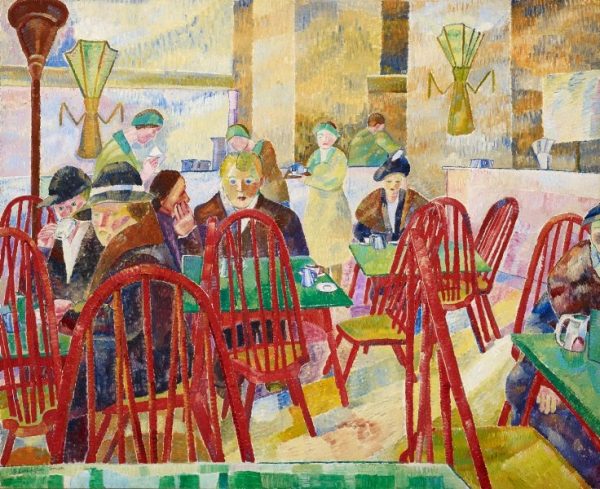
GRACE COSSINGTON SMITH’S ‘THE LACQUER ROOM’ (1934), COURTESY ART GALLERY OF NSW
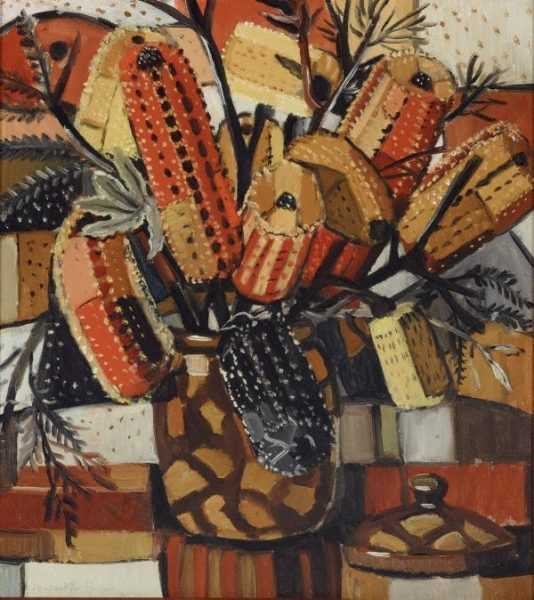
MARGARET PRESTON’S ‘THE BROWN POT’ (1940). COURTESY ART GALLERY OF NSW
Australia continued to embrace the wonders of modern technology. Aviation made headlines once again with the disappearance of first Charles Ulm in 1934, and then Sir Charles Kingsford Smith in 1935. The first international flight for Qantas Empire Airways departed for Singapore also in 1935. Australia and Britain were linked by a radio telephone service for the first time on 30 April 1930. That same year, a trunk telephone line connected Adelaide and Perth, catapulting even the far reaches of the country into modernity, while the Australian Broadcasting Corporation (ABC) was established in 1932 as the Australian Broadcasting Commission. Its first broadcast on 1 July 1932 is estimated to have reached six percent of the Australian population. By 1937 the ABC had permanent symphony orchestras in each state capital.[14]
By the outbreak of the Second World War in September 1939, Australia—and the world—was a thoroughly modern place. Though downtrodden by the Depression, the Australians who went to war were as determined and resilient as ever. Those who emerged out the other side did so to a world virtually unrecognisable from what it had been twenty years ago, when a newly federated Australia, freshly proven on the beaches of Gallipoli, plunged into the post-war unknown.
Exciting new world?
As co-curator of the Brave New World exhibition, Isobel Crombie, stated:
The 1930s in Australia isn’t the straightforward picture many people present it as; either art-deco or the Great Depression, where none of the complexities and juxtapositions are shown.[15]
These complexities existed in every aspect of 1930s Australian life, making it possible for optimism and despair to sit side by side at the table, at the picture theatre, in the seats of the MCG. The 1930s was a decade characterised by hardship; but for some there was hard-won success, too.
Australia in the interwar decades truly was an exciting new world. As we live through the centenary of the Roaring Twenties, we are reminded of just how changeable, and just how quick to change, life can be. Who knows what our own 2020s and 2030s have in store?
References:
[1] Annie Stevens, ‘Skint! Making do in the great depression’, Sydney Living Museums, accessed 14 October 2021, https://sydneylivingmuseums.com.au/stories/skint-making-do-great-depression.
[2] Lisa Featherstone, ‘Sex educating the modern girl: the formation of new knowledge in interwar Australia’, Journal of Australian Studies 34, no. 4 (2010): 459, DOI: 10.1080/14443058.2010.519103.
[3] ‘Great Depression’, National Museum of Australia, accessed 14 October 2021, https://www.nma.gov.au/defining-moments/resources/great-depression.
[4] ‘1930 to 1939 – Depression and Crisis’, Parliament of New South Wales, accessed 14 October 2021, https://www.parliament.nsw.gov.au/about/Pages/1930-to-1939-Depression-and-Crisis.aspx; ‘Great Depression’; Stevens, ‘Skint!’.
[5] ABC Rural, ‘From Gallipoli to Australian farms: Soldier settler success and failure and contribution to the future of agriculture’, ABC, 23 April 2012, https://www.abc.net.au/news/rural/2015-04-23/remembering-soldier-settlers-a-window-to-agricultural-past/6408988.
[6] ‘Australia in the 1930s – The Great Depression’, My Place, accessed 14 October 2021.
[7] Jack Lang, The great bust: the Depression of the thirties (Sydney: Angus & Robertson, 1962); Bede Nairn, ‘Lang, John Thomas (Jack) (1876-1975)’, Australian Dictionary of Biography, National Centre of Biography, Australian National University, accessed 30 October 2021, https://adb.anu.edu.au/biography/lang-john-thomas-jack-7027; Geoffrey Robinson, ‘The Rise and Fall of Jack Lang, Australia’s Renegade Labor Premier’, Jacobin, 27 February 2021, https://jacobinmag.com/2021/02/jack-lang-labor-premier-alp; ‘Australia in the 1930s – Jack Lang’, My Place, accessed 14 October 2021, https://myplace.edu.au/decades_timeline/decade/1930; ‘1930 to 1939’; Stevens, ‘Skint!’.
[8] ‘1930 to 1939’; Stevens, ‘Skint!’.
[9] ‘Australia in the 1930s – Indigenous Australians’, My Place, accessed 14 October 2021, https://myplace.edu.au/decades_timeline/1930/decade_landing_7.html?tabRank=2; Stevens, ‘Skint!’.
[10] ‘Brave New World: Australia 1930s’, media release, National Gallery of Victoria, 15 June 2017, https://www.ngv.vic.gov.au/media_release/brave-new-world-australia-1930s/; Tiarney Miekus, ‘Brave New World: Australia 1930s’, 13 July 2017, https://artguide.com.au/brave-new-world-australia-1930s/.
[11] ‘Australia in the 1930s – Sydney Harbor Bridge’, My Place, accessed 14 October 2021, https://myplace.edu.au/decades_timeline/1930/decade_landing_7.html?tabRank=4&subTabRank=4; ‘1930s Australia: the art deco designs ushering in a brave new world – in pictures’, The Guardian, 14 July 2017, https://www.theguardian.com/artanddesign/gallery/2017/jul/14/art-deco-travel-and-1930s-australia-in-pictures.
[12] ‘Don Bradman’, Melbourne Cricket Ground, accessed 30 October 2021, https://www.mcg.org.au/things-to-do/sporting-statues/don-bradman.
[13] ‘Australia in the 1930s – Film’, My Place, accessed 14 October 2021, https://myplace.edu.au/decades_timeline/1930/decade_landing_7.html?tabRank=3&subTabRank=3; ‘Art Sets. 20th-century Australian art: Colour and light: early modernism in Sydney’, Art Gallery of NSW, accessed 21 September 2021, https://www.artgallery.nsw.gov.au/artsets/fl43me.
[14] ‘Australia in the 1930s – Communications’, My Place, accessed 14 October 2021, https://myplace.edu.au/decades_timeline/1930/decade_landing_7.html?tabRank=4; Quentin Dempster, “A Short History of the ABC”, ABC Alumni, 24 October 2018, https://www.abcalumni.net/news-and-views/a-short-history-of-the-abc.
[15] Miekus, ‘Brave New World’.


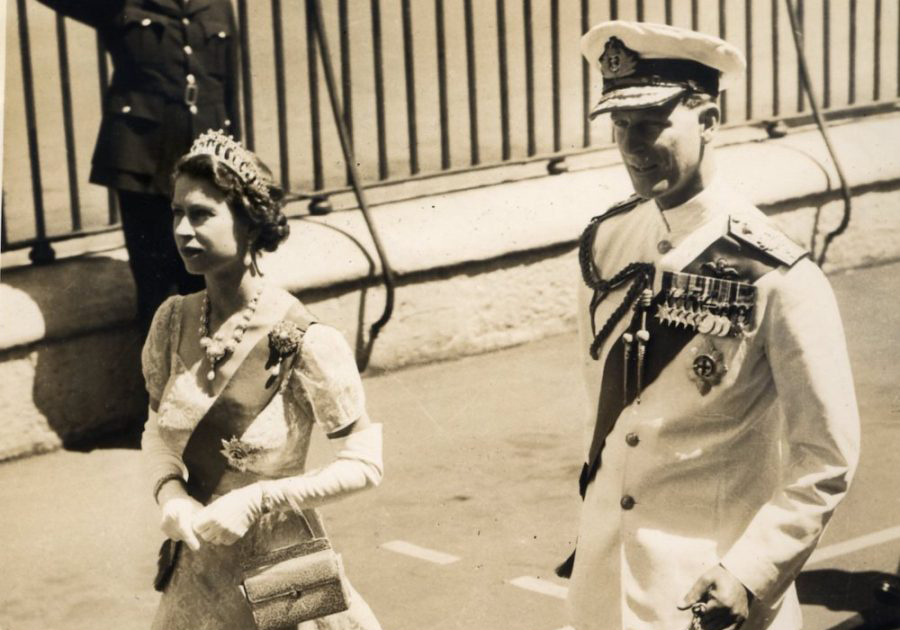
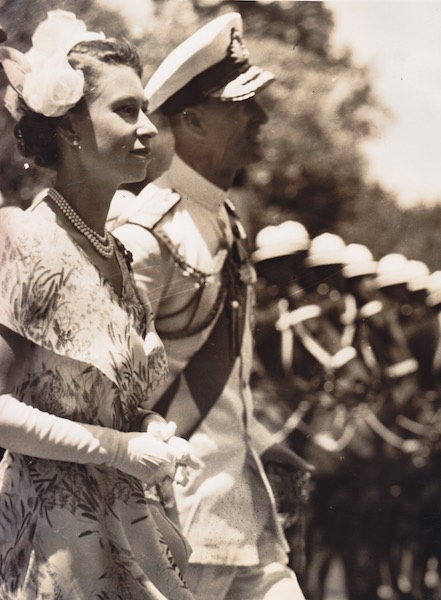 The RAHS would like to offer condolences to those close to Queen Elizabeth II who are experiencing a profound personal loss at her death. As the longest-reigning monarch in British history, the late Queen will be remembered for her enormous dedication to the role she performed for more than seventy years.
The RAHS would like to offer condolences to those close to Queen Elizabeth II who are experiencing a profound personal loss at her death. As the longest-reigning monarch in British history, the late Queen will be remembered for her enormous dedication to the role she performed for more than seventy years.